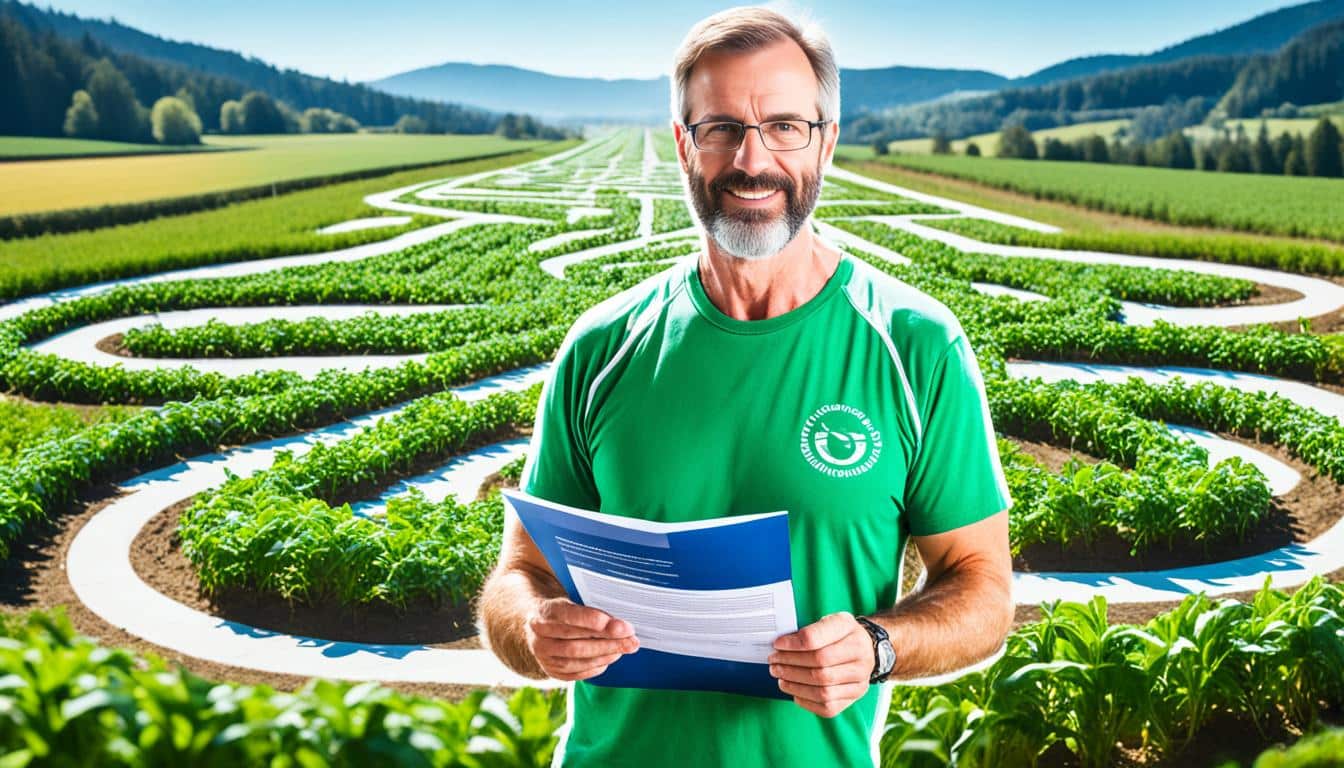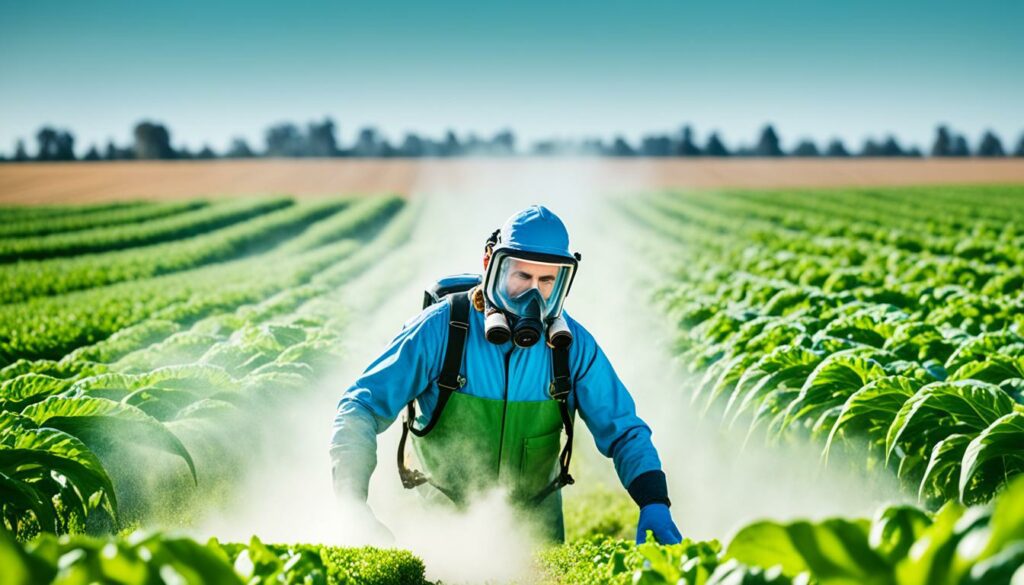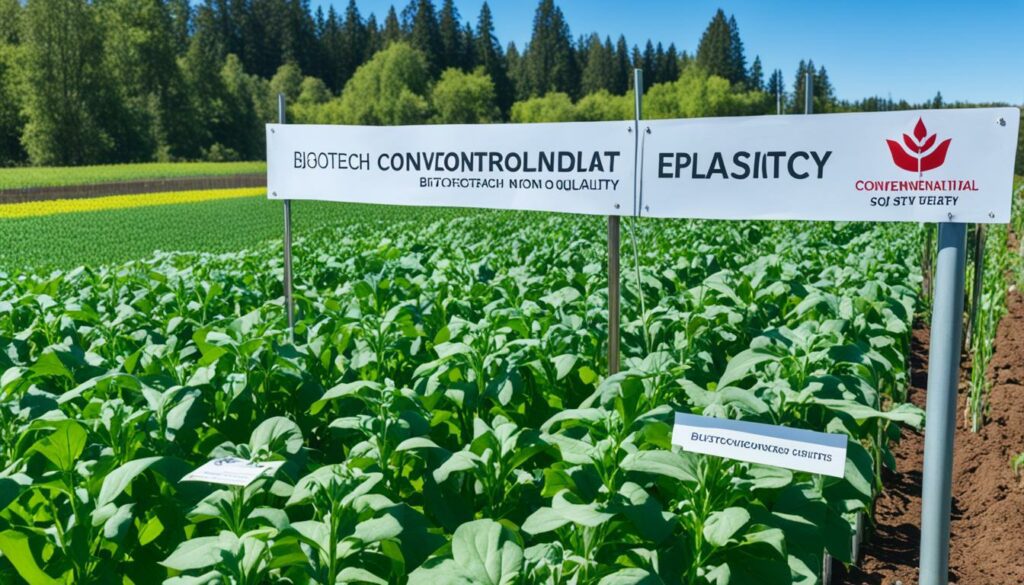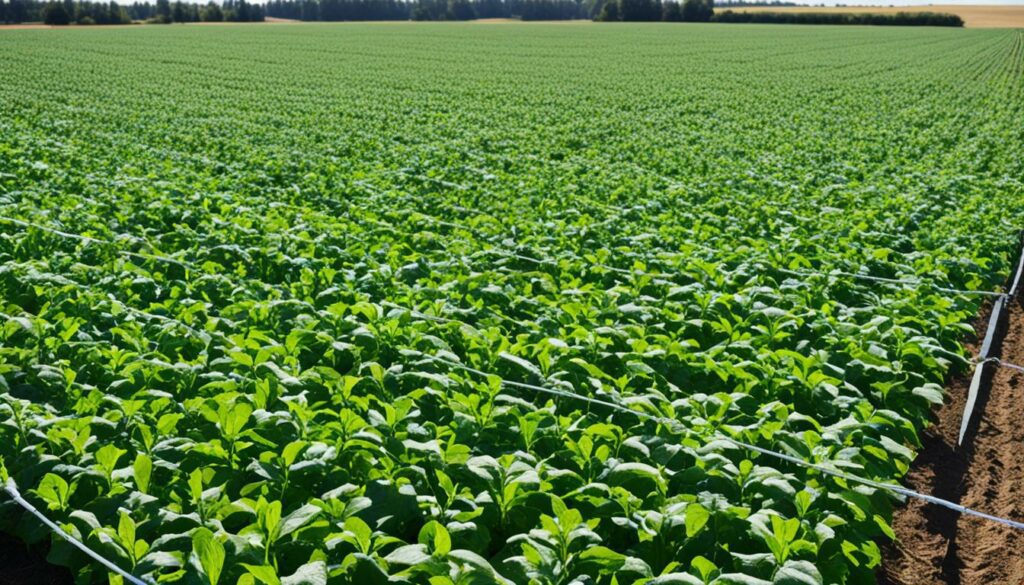Menu

By 2012, 88 percent of all corn, 94 percent of cotton, and 93 percent of soybeans in the United States came from biotechnology plantings. These massive numbers show how crucial biotechnological advances are in farming.
Since 1986, the U.S. has used the Coordinated Framework for Regulation of Biotechnology to make sure these products are safe. This system checks that biotechnology products don’t harm the environment, or human and animal health.
Three main agencies oversee the safety of these agricultural products: the USDA’s Animal and Plant Health Inspection Service (APHIS), the Environmental Protection Agency (EPA), and the Food and Drug Administration (FDA). They all work together. They check product details, share important information, and solve any safety problems as a team.
An organised effort is key to making sure biotechnology in farming is safe and effective. This way, the regulations support farmers and protect everyone’s well-being.
Biotechnology in agriculture has changed farming. It uses living things to improve crops and create new uses for them. In the US, laws are in place to handle these new products well. We will look at what biotechnology in farming means, why it’s important, and its history. This will help us understand its journey and current importance.
Biotechnology in agriculture includes using tools like genetic engineering. It improves plants’ natural abilities, making agriculture more productive and sustainable. This technology helps solve food security issues and increases crop production. The use of these techniques is closely managed to ensure they are used safely and responsibly.
For millennia, plant breeding has evolved crops far from their wild ancestors. Now, with biotechnology, agriculture is taking a big step forward. Both traditional and new methods, like hybrid seeds, play a key role. Hybrid corn in the USA and hybrid rice in China show how much these advancements can achieve.
These examples reflect biotechnology’s crucial role in improving agricultural practices. They have a big impact on how we farm, ensuring better future food production. Progress in the field is closely monitored to meet safety and sustainability goals.
In the United States, biotechnology in agriculture is regulated through the Coordinated Framework for Regulation of Biotechnology. This framework was set up in 1986. Its goal is to make sure biotechnology products are safe for the environment and people’s health.

The Coordinated Framework brings together three federal agencies: the USDA-APHIS, the EPA, and the FDA. They work together to check that agricultural biotechnology products are safe. This includes products like genetically modified organisms (GMOs).
USDA-APHIS looks after biotechnology products that might be risky under the Plant Protection Act. They decide if these products are safe through a detailed review. This includes looking at the risk they pose to plant health and their impact on other organisms.
The FDA ensures that food and feed from plants, including those made with biotechnology, are safe to eat. They require food additives to get their approval before being sold. The FDA also offers a process where makers of GMO foods can talk about safety before their products hit the market.
The EPA checks pesticides made through biotechnology. They do this under the Federal Insecticide, Fungicide, and Rodenticide Act. They make rules about how to use these pesticides safely and set how much can be left on food, known as residue.
By 2022, new laws mean that foods made through biotechnology must be clearly labelled. These rules are part of the wider approach to regulating biotechnology in farming. They make sure everything about biotechnology products, from safety to how they’re labelled, gets careful attention.
| Agency | Responsibilities |
|---|---|
| USDA-APHIS | Regulates biotechnology products under the Plant Protection Act, determining non-regulated status through a detailed petition process. |
| FDA | Ensures the safety and proper labelling of plant-derived food and feed, and manages a voluntary consultation process for genetically engineered foods. |
| EPA | Regulates biotechnological pesticides under FIFRA, establishing conditions of use and setting tolerance limits for residues. |
The USDA’s Animal and Plant Health Inspection Service (APHIS) is vital for protecting U.S. agriculture. They do this by keeping away pests and diseases. APHIS regulates products from modern biotechnology. This includes those that might be a plant pest risk. Their work is important for ensuring biotech farming is safe and sustainable in the U.S.
APHIS looks after the importation, interstate movement, and release of genetically engineered organisms. These are called “regulated articles” under the Plant Protection Act. Their duties help prevent harm to U.S. agriculture from biotech products. They make sure that laws on biotech farming are followed. Also, they check that new biotechnological ideas don’t harm plant health.
APHIS has a process for organisms to be seen as not needing regulation. This process is important for biotech farming’s progress. It means some biotech products might not need such strict checks if they’re proven not to be a pest risk. To get this status, applicants have to provide a lot of information, like genetic details and potential impacts. APHIS checks this information thoroughly. They make sure the laws are doing their job in a good, scientific way.
| Biotech Product | Regulatory Status | Responsible Agency |
|---|---|---|
| Genetically Modified Corn | Regulated | USDA APHIS |
| Biotechnological Pesticides | Regulated | EPA |
| Genetically Engineered Soybeans | Potentially Non-Regulated (via petition) | USDA APHIS |
| GM Food Labelling | Ensured Safety & Proper Labelling | FDA |
By following this structured approach, the U.S. can develop biotechnology in agriculture safely and efficiently. This ensures that the rules are strong and keep up with new ideas.
The Environmental Protection Agency (EPA) is key to making sure biotechnological pesticides are safe. They enforce rules under the Federal Insecticide, Fungicide, and Rodenticide Act (FIFRA). This helps keep us and the environment healthy.

The FIFRA is vital for what the EPA does. It makes sure any pesticide, even ones made with biotech, are safe. The EPA checks them well to avoid risks to people and nature.
The EPA’s special division for biopesticides oversees their use. They look at natural and genetically engineered biopesticides. And they make rules, like how much of them is safe for food.
“In response to President Biden’s Executive Order 14081, the EPA, in collaboration with the FDA and USDA, issued a stakeholder comments report to address concerns related to the Coordinated Framework for the Regulation of Biotechnology.”
The EPA doesn’t shy away from trying new things. Just this March 2022, they started using genetically modified mosquitoes. This is to help control wild mosquito numbers, an example of how the EPA adapts.
A strong plan to deal with biotechnological challenges is very important. The EPA uses FIFRA and other groups to stay ahead in this area. They make sure biotechnology in pesticides is safe and future-proof for farming needs.
| Key Aspect | Description |
|---|---|
| Regulatory Authority | EPA under FIFRA |
| Division | Biopesticides and Pollution Prevention Division |
| Registration Requirement | Mandatory for all biotechnological pesticides |
| Tolerance Limits | Established for residues on food and feed |
| Recent Initiatives | Testing of genetically engineered mosquitoes (March 2022) |
The FDA is key in making sure our foods are safe and well-labelled. They pay special attention to foods from genetically changed plants. They work closely with USDA and EPA to keep things clear and safe. This teamwork helps us trust our food and keeps new ideas coming. The FDA’s efforts make the rules easier to understand and follow.
The FDA wants food, whether for people or animals, to be safe. They make sure no food goes on sale until it’s been checked and meets their high safety levels. They also make it a must for food labels to tell us if there are any GMOs in the food. By 2022, thanks to the National Bioengineered Food Disclosure Standard, food labels will have to clearly show if they have been made with biotechnology.
The FDA helps food makers follow the rules through a special consultation program. This program has a few important steps:
By dealing with safety concerns early, this process helps make sure biotech foods are safe. The FDA keeps working with industry and the public to make food safety even better.
Permitting requirements are key for the safety of genetically engineered crops. They make sure these crops are safe and effective in farming.
For biotech crops to move between states or into the country, permits are crucial. They help avoid any plant health risks. Thanks to the USDA’s SECURE rule, the process has become faster since October 2021. This rule makes handling paperwork more efficient. Since August 2020, some genetically engineered plants don’t need permits for easier research.

Governments have rules for releasing engineered crops into the environment. These rules protect plant health. Now, getting approval for a new biotech crop only takes 41 days. This is because of new approval processes since April 2021. The APHIS Strategic Plan aims for quick reviews of GE crops. APHIS checks that these crops are safe before they reach the market.
| Year | Regulatory Milestone | Impact |
|---|---|---|
| August 2020 | SECURE Rule Exemptions | Streamlined Research & Development |
| April 2021 | Permitting Process Changes | Expedited Approvals |
| October 2021 | SECURE Rule Full Implementation | Improved Submission Efficiency |
Focusing on the permitting process is vital for protecting the environment while encouraging new ideas in farming. The USDA, EPA, and FDA work together to make sure these rules are strong and keep up with science changes.
The Regulatory Status Review (RSR) process helps make sure biotechnology crops are safe. It starts with the USDA’s Animal and Plant Health Inspection Service (APHIS) on August 25, 2021. They look at how to review and approve biotech crops.
For the RSR in biotech crops, a lot of information is needed. This includes seeing how these plants are different from non-biotech ones. Also, it looks at the changes made to these plants and any new traits.
Helping APHIS do a full risk check, this process makes sure biotech crops are safe. It ensures they follow all the strict rules and are as safe as can be.
Groups working on these crops have to give APHIS lots of details. They share everything about the plants, from how they’re different to their new traits. If APHIS asks for more, they must provide that, too.
This detailed process began on April 5, 2021, and was fully up and running by October 1, 2021. Following the SECURE rule by the USDA since May 18, 2020, these steps have been updated. This is to keep the system modern and effective.
APHIS uses key points to check if biotech crops are safe. They look at the changes made to the plants, the new traits, and how they compare to regular plants. A full risk check is also done.
This way of looking at things helps APHIS decide if these crops are safe to use. It’s informed and careful. In a webinar on September 21, 2021, they explained all these steps. This shows how serious and detailed the RSR process is.
| Key Dates | Event |
|---|---|
| May 18, 2020 | Publication of the SECURE Rule |
| April 5, 2021 | Partial Implementation for Select Crops |
| August 25, 2021 | Draft Guide Release |
| October 1, 2021 | Full Implementation of RSR |
The RSR process supports both growth and safety in biotechnology. Open to the public’s thoughts until October 25, 2021, it keeps a close eye on things. This helps build trust in using biotech in farming.
Knowing about biotech exemptions is key for those wanting to use genetic engineering in farming. APHIS sets clear rules for its use, ensuring safety.
Biotechnology helps increase crop yields. About half of farming’s growth is thanks to it. In the U.S., over 90% of corn, soybeans, and cotton are gene-edited.
APHIS has a special process for plants that are not risky to agriculture or nature. This makes it easier for safe gene-edited plants to move forward fast.
Getting confirmation is vital for developers. APHIS checks if these plants qualify for special rules. They must prove their plants don’t harm nature. The aim is to stop bad use of these plants, like unauthorized releases or moves across states.
Some recent cases, like soybeans and bananas, have been free from extra rules. This helps developers a lot.

These checks and approvals are based on strong science. APHIS keeps a close eye on new technologies while helping them grow.
| Key Aspect | Detail |
|---|---|
| Regulatory Authority | APHIS at USDA |
| Exemption Application | Developers submit detailed information |
| Review Process | Rigorous scientific assessments |
| Recent Examples | Soybeans, bananas |
| Purpose | Streamlined regulatory oversight for low-risk products |
Exemptions and confirmations help balance biotech growth with strong safety rules. This keeps traditional controls intact.
Regulations in biotechnology are very important to follow. APHIS puts in place a system to make sure companies in biotech follow the laws. They do this by inspecting these companies regularly to see if they are obeying the rules and guidelines.
Understanding what the rules say is the first step in following biotechnology regulations. APHIS checks new genetically engineered organisms to see if they are safe. The US Federal Seed Act means seeds must be labelled correctly, promoting fairness and honesty.
APHIS has set procedures for checking if companies follow the rules. They look through paperwork, make sure permits are current, and visit the places in person. These steps are key because APHIS deals with organisms that might harm plants.
Three federal agencies in the U.S. government—FDA, EPA, and USDA—regulate most GMOs to ensure a robust and coordinated approach to biotechnology compliance.
Below is a table showing the work different agencies do in biotech farming:
| Agency | Regulation Focus | Responsibilities |
|---|---|---|
| U.S. FDA | Food Safety | Checks the safety of human and animal food, including GMO foods. |
| EPA | Pesticides | Looks after pesticides and makes sure plant protectants are safe for the environment. |
| USDA APHIS | Agricultural Protection | Makes rules to prevent pests and diseases, and makes sure GMO plants aren’t harmful to other plants. |
Recent changes have shaken up biotechnology regulations, especially with the SECURE Rule’s introduction. This rule, by the USDA, aims to make it easier for all involved. It reduces the red tape around making and selling genetically edited items, helping both big players and newbies. Small groups like university labs and start-ups can now move their cool new products to market faster.

Under the SECURE Rule, managed mostly by APHIS thanks to the Plant Protection Act, several priorities stand out. First off, some edited organisms that are safe get a free pass, cutting unnecessary checks. Then, there’s a close look at how risky new edits might be, through a review called RSR. Finally, if your genetic tweaks might hurt plants, you still need a green light to go ahead, keeping things safe yet simple.
The SECURE Rule is especially good news for the little guys in biotech. They often struggle with high costs and slow rules, all now less of a problem. Thanks to smoother steps, they can get their products out there quicker and with less hassle. This hands a big advantage to places like university labs and fresh start-ups, spurring on clever ideas and better competition.
| Aspect | Previous Regulation | SECURE Rule Regulation |
|---|---|---|
| Regulatory Burden | High | Reduced |
| Review Timeline | Lengthy | Streamlined |
| Compliance Cost | Significant | Minimised |
| Innovation Speed | Slower | Faster |
| Small Developer Challenges | Substantial | Diminished |
The SECURE Rule has made it simpler and safer to dive into biotechnology, giving a boost to creative minds. By focusing on potential risks and easier rules, it aims to change the game, especially for those just starting out. This forward-thinking rule promises big wins for small-scale developers in the ever-evolving world of biotech.
The world of biotechnology regulation has big challenges. These issues mainly affect small developers. They get stuck in complicated rules, causing long regulatory review delays. These delays stop new products from coming to the market on time. It makes everything uncertain.
Reviews on Regulatory Status are slow and not the same everywhere. The slow use of new crops in Africa and South Asia shows how the local farming ways impact biotechnology. These delays add difficulties for small companies. They make it hard for new biotechnology to reach places that need it most, complicating farming improvements.
Starting biotechnology projects is hard for small companies. They face high costs and long regulatory review delays. They also lack enough scientific resources. Plus, big seed companies don’t focus on important crops like cassava and yams in poor countries. To help these areas, we need to make technology that fits local needs.
| Challenges | Impacts |
|---|---|
| Regulatory Review Delays | Slows the market entry of new biotech products; affects timely advancements. |
| High Compliance Costs | Places dis-proportionate financial strain on small developers. |
| Lack of Support for Orphan Crops | Neglects essential crops for developing countries, hindering agricultural progress. |
| Limited Scientific Resources | Restricts the capacity for small firms to innovate and comply with regulations effectively. |
The world’s biotechnology rules need a good balance. We must keep things safe but also help new ideas grow. Dealing with regulatory review delays and helping small firms are very important. To give these small companies a chance, we need to make rules simpler and support them better. This way, they can really help improve farming with new biotechnologies.
The international biotech trade is hugely affected by US rules. Agencies like the USDA, FDA, and EPA set up strong guidelines. This ensures products from biotech are safe, building trust globally in US regulations. This trust is key for smooth trade and acceptance of US biotech globally.

Global faith in US rules is vital for worldwide biotech trade. Oversight by the USDA and FDA makes other markets trust the safety and quality of US biotech. This is thanks to the strict checks and thorough reviews biotech crops go through. Countries around the world, such as those in Europe, Latin America, and Africa, use these reviews to decide on imported biotech crops.
The US ranks top in exporting farm goods, with a lot being biotech. This shows how critical the international biotech trade is for the US economy. It also shows the trust in US regulations. For instance, high percentages of corn, soybeans, and cotton were genetically engineered by US farmers in 2012.
Biotech crops are grown in 29 countries and imported by 42. This reflects the global trust in US-managed biotech. To boost this trust, the USDA has started projects like the Advisory Committee on Biotechnology and 21st Century Agriculture (AC21). They look at the future of biotech and ways it can work alongside other farming methods. These actions strengthen the international biotech market and trust in US regulations. They help in the safe and effective trading of biotech goods worldwide.
This strong regulatory approach is crucial for the biotech trade’s success and trust in US rules. It helps create a safe and positive environment for agricultural biotechnology worldwide.
In the world of farming, biotechnology is a key player in making practices more green and efficient. Back in 2012, a big portion of crops in the US were from biotech – 88% corn, 94% cotton, and 93% soybeans. Farmers trust in these methods, seeing the good for the environment. The USDA’s NASS also supports this view.
Biotech crops help lower the gases that harm our atmosphere. They allow a big drop in the use of chemical pesticides. This helps keep our water safer and reduces the gas from making these chemicals. Less use of these chemicals means our farming is more in line with helping the planet. This is good news for fighting climate change.
Better genetics are at the heart of the biotech revolution. With new technology, crops can have better traits. For example, rice can have more beta-carotene to fight vitamin A shortages. Crops are also being made to fight diseases, like papaya plants resistant to harmful viruses. These changes mean we get more from our crops, which is not only good for the Earth but also for making farming sustainable and profitable.
Biotech crops make farming easier and safer for farmers. They’re a key part of being able to feed around 10 billion people by 2050 without harming our planet too much.
The Coordinated Framework for Regulation of Biotechnology began in 1986. It’s a risk-based system in the U.S. to make sure biotechnology products are safe. It’s for the environment, and for human and animal health. It involves the USDA’s Animal and Plant Health Inspection Service (APHIS), the EPA, and the FDA under the Department of Health and Human Services.
The USDA’s APHIS looks after crops, shielding them from pests and diseases. It does this under the Plant Protection Act. It keeps a close eye on genetically engineered organisms to make sure they’re safe. These are called “regulated articles.” Developers can ask to lessen this scrutiny. To do this, they need to provide details about the risks their organisms might pose.
The use of biopesticides in farming follows the Federal Insecticide, Fungicide, and Rodenticide Act, known as FIFRA. The EPA makes sure that these biopesticides are used safely. This is part of keeping the environment secure from harmful chemicals.
The FDA makes sure that foods and feeds from plants are safe by asking manufacturers to check in with them. This is done through a consultation process. With this process, they look at the food’s safety and how well it follows the rules. They offer advice to the companies. This happens before the food is sold to the public.
For any genetically engineered organisms being moved around or released into the environment, there are permitting rules. These rules are to make sure they’re safe to handle. They must meet certain standards to get a permit.
Regulatory Status Reviews are to check if genetically engineered plants are different enough to be risky. Developers give a lot of information so APHIS can do a complete risk check. They look at the changes in genes, new traits, and more information the developers give.
Developers can ask for certain plants to be not as strictly regulated if they prove these plants are not risky. APHIS helps them do this checking. If they pass, the plants won’t have to meet all the tough regulations.
APHIS keeps a tight check on biotech companies. They make regular visits and make sure everyone is following the rules. This works to keep the agricultural biotech world safe and in line with the law. It also helps protect people and the environment.
The SECURE Rule is a newer set of rules to make handling gene-edited crops easier. It cuts down on how much regulation they face. This is good for both big businesses and small groups like university labs. It helps get new products out into the world quicker.
Small developers can run into problems. They might face delays in getting their crops checked for risk. Compliance can also be very costly. These issues slow down getting their products to market and can be a big drain on their finances.
The US’s strong biotech regulations are trusted worldwide. This trust makes trading biotech products easier. It helps support the sale of US biotech goods across the globe. This, in turn, leads to stronger trade relationships.
Biotech crops bring many good things for the environment. They reduce harmful gases from farming, make crops stronger against bugs and disease, and boost the amount of food we can grow. They also improve the genes of our crops. This means we don’t need to cut down as many trees and waste less food. So, farming becomes more eco-friendly.